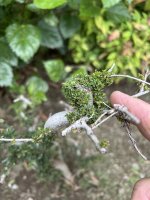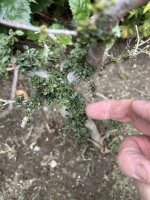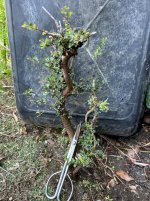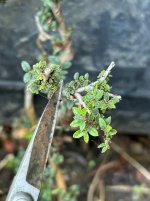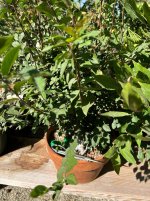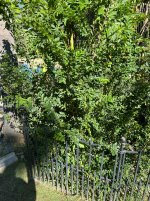You are using an out of date browser. It may not display this or other websites correctly.
You should upgrade or use an alternative browser.
You should upgrade or use an alternative browser.
Mutant Chinese Elm
- Thread starter Vince Sartain
- Start date
shohin_branches
Omono
Have you fertilized it at all since planting? Were the leaves normal before putting it in the ground?
Vince Sartain
Sapling
I took the root cutting in 2024 spring repot , potted it up with about 10 others and let them grow for a year. Then this early spring I stuck them in the grow bed in the yard. I didn't notice anything odd when I planted it but I'm sure it didn't have any leaves on it. Fast forward to about April this year I noticed that the leaves were tiny especially compared to the others I had planted. I thought well they'll catch up to the others here soon but as of yesterday they are still very tiny. They don't get any fertilizer other than the micro-dose I give daily with every watering. The others are literally 5 foot branches shooting up with regular 3/4" leaves. I don't get it, none of the mother plants that I took the cuttings from have small leaves. I always thought that cuttings would be a clone of the parent plant but not this one. Any ideas would be appreciated.Have you fertilized it at all since planting? Were the leaves normal before putting it in the ground?
Well, not to say that this is the reason, but some chemicals can cause mutations like this.
I remember seeing a YouTube video about an older CA bonsai practitioner who had some of the elms like that and he was saying that one application did it and it lasted, but the chemical was banned. What I don't remember is what channel it was and who the practitioner was...
So pretty useless info...
I remember seeing a YouTube video about an older CA bonsai practitioner who had some of the elms like that and he was saying that one application did it and it lasted, but the chemical was banned. What I don't remember is what channel it was and who the practitioner was...
So pretty useless info...
MrFancyPlants
Masterpiece
I’ve seen one with similar sized leaves growing out of a brick wall; “teeny tiny”, I believe is the technical term. I tried to dig it out of the wall, but it didn’t surfvive the operation to see if the leaves would stay small.
You should try and grow it out. Maybe airlayer into a thimble size sumo.
You should try and grow it out. Maybe airlayer into a thimble size sumo.
Vince Sartain
Sapling
I think I'll leave it alone till spring and see what happens but I'm tempted to dig it this coming spring and just pot it up and see what happens but I'd hate to have it die for some reason.
rockm
Spuds Moyogi
This could be a few things. Some of them not so good. Could be side effects from physical damage (note all the pruned and/or broken branching surrounding the patch of small leaves. Could also be insect attack (leaf gall etc) or infection.
Jrmcmich
Chumono
Different tree type (trident maple) I had similar thing happen over course of 2 years. Leaves were very tiny compared to other tridents I had. This year late spring I decided to put it in ground and finally have noticed new growth and larger leaves. Was wondering if I had A root issue in container that caused literally no growth. A bit different as your seeing this in the ground vs container. Be interesting to see roots when you pull it
stubmle
Mame
Very interesting... wonder if it's due to random variation in gene expression or an epigenetic change. In the first case: even when genotypes are identical between organisms, sometimes you get variance in the way they are expressed, which can cause phenotypical differences (think of how identical twins have different fingerprints).
Epigenetic changes are similar in that they result in a heritable change to some characteristic without altering the actual genes, but they're caused by exposure to some external influence (such as a pesticide), not random chance. I think that would be what's happening in the case KateM mentioned, or Frank Yee's cork-bark jades (corking developed after exposure to DDT); their genes weren't directly altered by the chemicals they were exposed to, but their physical expression was, and this change persists in new tissue long after initial exposure.
It could also be a disease, or physical or environmental stresses like rockm mentioned. What are those white spots on the leaves? Do your other elms from the same batch have similar leaf color, etc.?
Epigenetic changes are similar in that they result in a heritable change to some characteristic without altering the actual genes, but they're caused by exposure to some external influence (such as a pesticide), not random chance. I think that would be what's happening in the case KateM mentioned, or Frank Yee's cork-bark jades (corking developed after exposure to DDT); their genes weren't directly altered by the chemicals they were exposed to, but their physical expression was, and this change persists in new tissue long after initial exposure.
It could also be a disease, or physical or environmental stresses like rockm mentioned. What are those white spots on the leaves? Do your other elms from the same batch have similar leaf color, etc.?
shohin_branches
Omono
I do like to caution people about getting excited about mutations before pest/disease/chemical damage/nutrients are ruled out. I have had it happen to me many times and it's a total bummer. I currently have two elm root cuttings giving unstable variegation. One year one grows variegated leaves. The next year the other one does it.
Can you take some clear photos of the leaves without the artificial background blur? Sometimes you have to put your phone camera in pro setting to accomplish it.
Can you take some clear photos of the leaves without the artificial background blur? Sometimes you have to put your phone camera in pro setting to accomplish it.
Kanorin
Omono
What did the leaves of the donor tree look like (you said it's a root cutting)?
rockm
Spuds Moyogi
Doesn’t look like a genetic mutation to me. I’ve seen similar responses to damage in trees in my neighborhood. This ain’t a witches broom of dwarf genetic material. It’s some kind of response to physical stress
Vince Sartain
Sapling
I took Shohin-branches advice and took a few other photos with a neutral background as well as one of the mother plant and the bed with the other cuttings I took at the same time. The tiny leafed elm is only a few feet away from these other cuttings.
Attachments
Vince Sartain
Sapling
The only chemical that the yard has experienced is an insecticide named Wisdom that I use to control the little Argentine ants that invade my yard every summer. The little white spots I have no idea but as I have taken more photos today the spots are no longer there in any quantity.Very interesting... wonder if it's due to random variation in gene expression or an epigenetic change. In the first case: even when genotypes are identical between organisms, sometimes you get variance in the way they are expressed, which can cause phenotypical differences (think of how identical twins have different fingerprints).
Epigenetic changes are similar in that they result in a heritable change to some characteristic without altering the actual genes, but they're caused by exposure to some external influence (such as a pesticide), not random chance. I think that would be what's happening in the case KateM mentioned, or Frank Yee's cork-bark jades (corking developed after exposure to DDT); their genes weren't directly altered by the chemicals they were exposed to, but their physical expression was, and this change persists in new tissue long after initial exposure.
It could also be a disease, or physical or environmental stresses like rockm mentioned. What are those white spots on the leaves? Do your other elms from the same batch have similar leaf color, etc.?
Vince Sartain
Sapling
Perhaps you're correct, but its just odd that the other cuttings are not affected in the least.Doesn’t look like a genetic mutation to me. I’ve seen similar responses to damage in trees in my neighborhood. This ain’t a witches broom of dwarf genetic material. It’s some kind of response to physical stress

